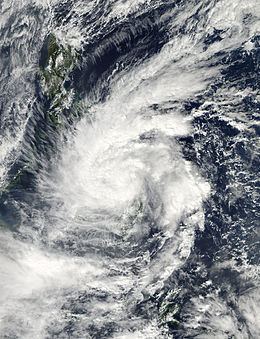Formed December 28, 2014 Fatalities 66 confirmed | Dissipated January 1, 2015 Highest wind speed 83 km/h | |
 | ||
Highest winds 10-minute sustained: 75 km/h (45 mph)1-minute sustained: 85 km/h (50 mph) Lowest pressure 996 hPa (mbar); 29.41 inHg Damage $28.3 million (2014 USD) Date 28 December 2014 – 1 January 2015 Similar Typhoon Jangmi, Typhoon Hagupit, Typhoon Durian, Tropical Storm Fung‑wong, Tropical Storm Lingling | ||
Tropical Storm Jangmi ([tɕaŋ.mi]), known in the Philippines as Tropical Storm Seniang, was a weak but destructive tropical cyclone that impacted the Philippines during late December 2014. It produced heavy rainfall which caused serious flooding. Flooding in Philippines caused 66 deaths and at least $28.3 million damage.
Contents
The last of twenty-three named storms of the annual typhoon season, the late-season cyclone remained weak throughout most of its lifespan. The tropical storm reached peak strength on December 29 near Surigao del Sur, Mindanao. Jangmi dissipated just before the 2015 Pacific typhoon season started.
Meteorological history
On December 26, both the JTWC and PAGASA started to monitor a tropical disturbance well east of Mindanao, Philippines just where Sinlaku formed. On December 27, the JMA started to monitor a tropical depression, that had developed within favourable conditions for further development, about 630 km (390 mi) to the west of Koror, Palau. Over the next day the depression gradually developed further and was named Seniang by PAGASA as it moved northwesterly along a ridge of high pressure, while atmospheric convection wrapped into the system's low level circulation centre. Both the JTWC and PAGASA upgraded the depression to a tropical storm late on the same day.
Early on December 29, the JMA upgraded the system to a tropical storm, naming it Jangmi. At the time of the upgrade, Jangmi made landfall over the town of Hinatuan in the province of Surigao del Sur. The storm traversed the CARAGA region, and exited the landmass of Mindanao during the afternoon hours of the same day, as it had accelerated to the northwest. Late on December 30, Jangmi made landfall over Cebu and southern Negros, right before the JTWC downgraded it to a tropical depression. On December 31, the JTWC issued the final warning to Jangmi, and the JMA downgraded it to a tropical depression at noon the same day. The system was last noted by the JMA and the JTWC on January 1, 2015, dissipating over Borneo, just before the 2015 Pacific typhoon season started.
Philippines
Tropical Storm Jangmi made landfall in Surigao del Sur on December 29. It produced heavy rains and caused flooding in Southern Philippines.
In Malacañang, PCOO Secretary Coloma defended the government from criticism that not enough was done to prevent the high casualty count, saying agencies gave timely warnings and that President Aquino had directed government to mobilize all resources to help the victims.
Retirement
Because the total cost of damage reached at least ₱ 1 billion, the name Seniang was retired by PAGASA, and replaced by Samuel for the 2018 season.
